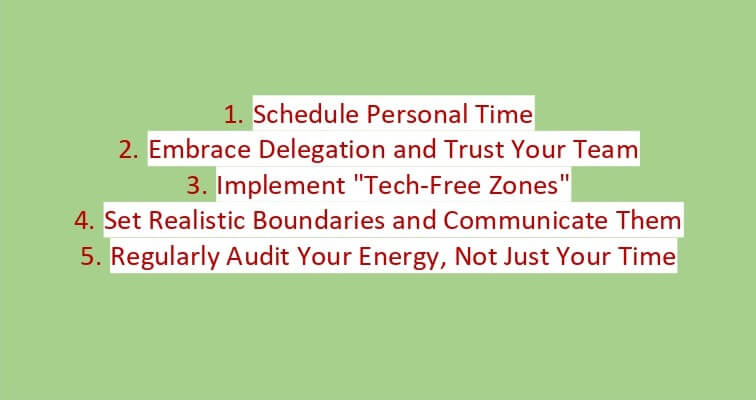Sanya Onayoade
Introduction
If you’re a busy executive, chances are your calendar is packed, your phone never stops buzzing, and your to-do list feels like it’s on a permanent uphill climb. Between back-to-back meetings, strategy sessions, and constant decision-making, finding time for yourself can feel like a luxury you simply can’t afford. But here’s the hard truth: without a conscious effort to balance your professional demands with personal well-being, even the most driven leaders risk burnout, strained relationships, and declining performance.
Work-life balance isn’t about working less — it’s about living better. It’s about designing a rhythm that sustains both your ambition and your well-being. In this post, we’ll explore realistic, actionable strategies tailored for high-performing executives like you. Whether you’re looking to reclaim small pockets of personal time, improve your mental clarity, or simply breathe a little easier at the end of each day, you’ll find practical insights to start making meaningful changes today.
Because your success shouldn’t come at the expense of your life.
Practical Strategies to Reclaim Your Life
In today’s relentless corporate landscape, the title of “executive” often comes with invisible chains: endless meetings, constant decision fatigue, and a gnawing sense that no matter how much you achieve, there’s always more to do. For busy executives, work-life balance can feel like an elusive ideal — a luxury reserved for others. Yet, the truth is stark: without balance, even the sharpest minds dull, relationships fray, and health silently erodes.

Apart from other health challenges, mental health is a big factor in unbalanced work-life. Mental health encompasses a range of aspects such as emotional Well-being, psychological well-being and social well-being. Healthy mental health involves maintaining positive relationships and a strong support network. Social interactions, friendships, and connections with others contribute to a sense of belonging and provide emotional support.
Executives juggle boardroom pressures, global responsibilities, and personal commitments, leaving little room for self-care. Yet, as former Google CFO Patrick Pichette once wrote, “Life is a series of trade-offs” – and mastering these trade-offs is the key to sustainable success.
The Illusion of “Having It All”
When EY CEO Mark Weinberger skipped a high-profile meeting at the Great Wall of China to attend his daughter’s driving test, he sent a powerful message: “True leadership isn’t about being everywhere – it’s about being where it matters most”. His decision resonated deeply with employees, proving that modeling balance inspires teams more than any corporate initiative.

EY CEO, Mark Weinberger. Photo: Reuters
With intentional, practical steps, you can build a life where your professional ambitions and personal well-being thrive side by side.
The High Cost of Imbalance
Let’s begin with a story. David, a regional director at a fast-growing tech firm, was known for his exceptional drive. He arrived at the office before dawn and left long after sunset. On paper, he was the embodiment of success. But behind closed doors, David’s health was declining. He’d skipped his annual physical for two years, dismissed family dinners in favour of client calls, and hadn’t taken a real vacation in nearly five years.
It wasn’t until a minor health scare forced him into the emergency room that David realised: productivity without personal care is a recipe for collapse. Today, David schedules quarterly health check-ins, blocks out non-negotiable family time, and delegates more — finding not only relief but renewed energy in his role.
David’s story is not unique. Studies consistently show that burnout affects more than 60% of executives globally. Prolonged stress diminishes cognitive function, creativity, and emotional resilience — essential traits for any leader. Recognising the risks is the first step toward building a better balance.
Understanding the Unique Challenges Executives Face
Why is work-life balance especially tricky for executives?
High responsibility, low flexibility: Senior roles demand rapid decision-making, often across multiple time zones.
Pressure to model availability: Executives feel compelled to always be “on,” setting a precedent for their teams.
Blurring lines between personal and professional life: Technology ensures work follows you everywhere.
These factors create a dangerous loop: the more successful you become, the harder it feels to step back.
5 Practical Strategies to Restore Balance
- Schedule Personal Time as Rigorously as Business Meetings
If your calendar rules your day, make it your ally. Block out time for exercise, family dinners, personal development, or even quiet reflection. Treat these appointments with the same respect as board meetings.
Executives like Maria, a CFO of a multinational company, credit this simple shift as life-changing. Maria started with just 15-minute morning walks and expanded to a full hour of daily “unplugged time.” She reports greater mental clarity and sharper decision-making at work.

2. Embrace Delegation and Trust Your Team
One of the hallmarks of effective leadership is empowering others. Delegation frees your time and develops your team’s capabilities. Resist the urge to micromanage. Focus on high-impact tasks only you can handle, and trust your team with the rest.
3. Implement “Tech-Free Zones”
Constant notifications fragment your attention and extend your workday unnecessarily. Establish tech-free times or zones — for example, no emails after 8 PM, or device-free family meals. This small discipline can create meaningful separation between work and life.
4. Set Realistic Boundaries and Communicate Them
Transparency is crucial. Let your team and clients know your availability windows and respect them yourself. Modelling healthy boundaries empowers others to do the same, creating a more balanced workplace culture.
5. Regularly Audit Your Energy, Not Just Your Time
Not all tasks are equal in energy demand. Recognise which activities drain you and which energise you. Restructure your day to tackle high-energy tasks when you’re at your peak, and intersperse restorative breaks throughout.
The Role of Mindset in Achieving Balance

Beyond strategies, mindset matters deeply. Many executives carry an ingrained belief that relentless hustle equals success. But research and real-world examples increasingly debunk this myth.
High-performing leaders today prioritise sustainable excellence over burnout-fuelled bursts of productivity. They understand that rest is not a reward — it’s a requirement for high performance. Shifting from a “work first, life later” mentality to “integrated well-being” is transformative.
Investing in Yourself is an Investment in Your Leadership
Your role as an executive places you in a position of influence, not just over business outcomes but over workplace culture itself. By prioritising balance, you not only safeguard your personal well-being but also set a powerful example for your team.
When leaders model healthy habits, organisations benefit from reduced turnover, higher morale, and sustained performance. It starts with simple choices: stepping away from your desk for lunch, saying no to non-essential meetings, or simply breathing deeply between calls.
Final Thoughts
Work-life balance for busy executives isn’t about perfect equilibrium — it’s about finding a sustainable rhythm that fuels both your ambition and your well-being. It requires deliberate choices, protective boundaries, and, perhaps most importantly, the belief that you deserve a life outside your title.
So take a moment today to pause and reflect. Ask yourself:
What’s one small action I can take to reclaim part of my personal life this week?
How can I protect time for what truly matters?
Remember, success and satisfaction are not mutually exclusive. In fact, they flourish best together.
Your leadership journey is a marathon, not a sprint. Pace yourself, live fully, and lead well.
Reference: Business Insider, Hirebee, CMA Consult, LinkedInEditors

